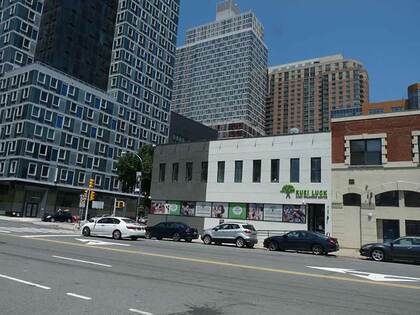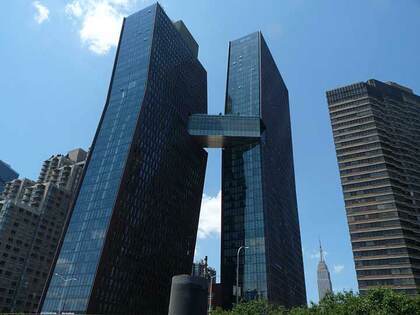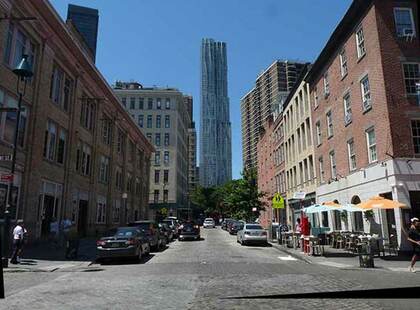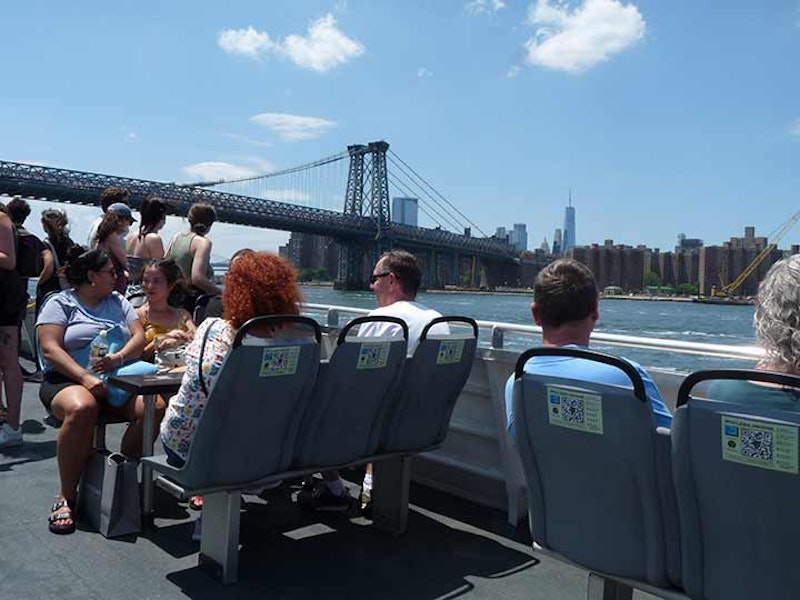Beset by nagging maladies and injuries, I was in the mood for an easier walk during the recent holiday weekend and remembered I hadn’t taken full advantage of NYC Ferry, which offers travel to several disparate neighborhoods in all five boroughs for the (heavily subsidized) cost of a subway ride, $2.75. So far, the service has attracted wealthier business riders during the week and sun-trippers on the weekend; the problem lies in the riverside terminals, where few subway lines approach.
In future rides, I plan on riding between regions that present a contrast, such as say Corlears Hook and Governors Island, or E. 90th St. and Soundview, Bronx (I’s taken NYC Ferry there a few years ago). Today, I went from Hunters Point to Pier 11 Wall Street; the ferry makes stops at E. 34th, Greenpoint (currently closed for repairs), North and South Williamsburg, DUMBO and Wall St., which is the ferry hub as all lines end up there as the first or last stop (except for the W. 39th to St. George line).
To begin, I walked from the Vernon-Jackson #7 subway to the ferry landing. This is the south end of Vernon Blvd. at Borden Ave.; you can see new residential towers going up in Greenpoint in the background. In the 1970s or 80s, when I first bicycled from Bay Ridge to Hunters Point using the Pulaski Bridge, it was possible to walk across these unelectrified Long Island Rail Road tracks to a Vernon Blvd. stub on the other side. Until the 1950s this intersection was shadowed by a ramp taking Vernon Blvd. traffic over the Vernon Boulevard Bridge, which connected it with Manhattan Ave. in Greenpoint. When it was demolished, the Pulaski Bridge connecting 11th St. in Queens with McGuinness Blvd. in Greenpoint replaced it.

In the shadow of the former LIRR Powerhouse, on Borden Ave. and 2nd St. in Long Island City across the street from new residential towers, you’ll find what used to be the Waterfront Crabhouse, located in a two-story brick building. Its present blandish exterior reveals no clue of its former role as Tony Miller’s Hotel, a social epicenter of Long Island City.

Miller constructed a lavish, three-story hotel here in 1881, described as containing a huge horseshoe-shaped bar formed from a single piece of black walnut; three dining rooms; and 30 bedrooms on the third floor. It was quickly able to attract a sizable and star-studded clientele that included architect Stanford White (who co-designed the massive powerhouse a block north), auto racer Barney Oldfield, boxer Tim Sullivan, and entertainer Lillian Russell. Teddy Roosevelt was seen at Miller’s, and Grover Cleveland was spotted drinking at the bar. The hotel and restaurant’s eminence derived directly from its location across the street from the former Long Island City terminal of the Long Island Rail Road. Prior to 1910, when Penn Station was opened, Long Island City was as far west as the railroad got in Queens.
The hotel lost momentum after Tony Miller’s death in 1897 and the LIRR Manhattan connection was instituted in 1910. In 1919, Prohibition dealt the final blow and the hotel was shut down. The building subsequently served as a phonograph factory, a warehouse, and went through other stints as a restaurant and a hotel. A 1975 fire claimed the third floor. Restaurateur Anthony Mazzarella opened the Waterfront Crabhouse in 1978, and it attracted famous visitors just as Tony Miller’s did in the old days.
Mazzarella, a boxing fan and promoter, surrounded the bar with boxing memorabilia as well as subway signs, board games, advertisements, bottles, framed pictures, and other donated artifacts. One wall was full of sheet music; another with photographs of what the Crabhouse was like in the golden age of Tony Miller. After Tony Mazzarella’s recent death, his family decided not to continue running the Crabhouse. The building in 2022 was hosting the Kuei Luck Early Childhood Center.

It was time for a ferryboat ride. The boat cut directly across the East River to 34th St., the terminal of a long-ago ferry (see 1800s photo of the Miller Hotel above). Just as in Hunters Point, tall residential buildings dominate the region surrounding it such as the K-shaped American Copper Building towers, one of which has an unusual angled design that makes them look from across the East River in Hunters Point as a giant reverse letter K or perhaps a crooked letter H. The two towers are residential, despite their industrial sounding name, and are connected by a pedestrian skybridge. The two buildings do have copper cladding; both opened for occupation in 2018.

Can a building look angry? I’ve always thought the Continental Center, originally built for an insurance company at South St. and Maiden La., looks like it’s in a mood, with an impenetrable glassy face and sharp angles you could cut yourself on. The octagonally-shaped building opened in 1983, the same year as the South Street Seaport. After alighting in Manhattan, I headed west along Maiden La., which, the story goes, was named in the Dutch era in the 1600s for women washing clothes in a stream that now runs in the sewer system.

Fletcher St. is an unremarked-on narrow alleyway that has had numerous building projects springing up alongside it in recent years. Nonetheless, it has been permitted to retain its Belgian block paving. The street is named for Benjamin Fletcher, a British NY governor from 1692-1698 who awarded printing contracts to William Bradford and installed the guns at Fort George at the Battery. He also awarded Trinity Church funds to construct its first church through the sale of drift whales that had washed up on the shore (bones, blubber etc. could be put to good use).

#135 John St. is perhaps most famed for the digital clock designed by graphic designer and instructor Rudy de Harak (1924-2002). It was installed in 1971 as part of the building next door, 200 Water St.. The clock is 45×50′ tall and consists of 72 illuminated squares, the top row numbered 1 to 12 and the bottom squares numbered 00 to 59. When it worked the clock displayed the correct hour (the squares on top) minute and second, with the numbers flashing on every second from 00 through 59. When I passed it on July 3rd, it was showing the correct time, 1:52 p.m.

New York City has formal, informal and completely accidental homages to those who died in the sinking of the HMS Titanic on April 15, 1912. On the corner of Fulton and Water Sts. stands a reminder. The Titanic Memorial Lighthouse was dedicated exactly one year after the sinking and was originally placed atop the Seamen’s Church Institute, a 14-story building at South Street and Coenties Slip downtown. In 1967 the Seamen’s Institute moved and the building was later demolished; the lighthouse, fortunately, was preserved and by 1976, was installed at its present location. The tall pole at the apex originally had a metal ball that, when signaled by a telegraph at the National Observatory in Washington, DC, would drop at noon daily. The memorial hasn’t been tended to in recent decades, and a group has been founded to reverse the deterioration.
This block of Water St. was on the waterfront during the colonial era, until landfill extended Manhattan island further east and Front St. was constructed, and later further east and South St. was built.

#8 Spruce St., formerly the tallest residential building in NYC, since surpassed. It’s now known as New York By Gehry, after its architect, Frank Gehry; it’s his first major building in NYC after many years. The tower contains only rental units (898 in total), something of a rarity in New York’s Financial District. It contains a public elementary school, which the Department of Education owns, and is made of reinforced concrete. It’s 76 stories and 870 feet high.
I like the building, even though a number of friends don’t seem to like anything built later than 1950. I say that in jest, not in anger. I do like that Manhattan is dynamic, but so many of the new towers going up in places that never had them before like Hudson Yards and Hunter’s Point are plain glass boxes. #8 Spruce is new and different.

In one of the great travesties of the modern era, Pier 17, which catered to people with moderate incomes, was demolished in 2018 and a much more ambitious substitute with expensive restaurants and a rooftop arena (which I was shooed out of) took its place. As part of the demolition derby, the 1907 Tin Building, where so many Fulton Fish Market transactions took place, was razed and this note for note reconstruction took its place. No more can I get a cheap tuna pasta salad here.
—Kevin Walsh is the webmaster of the award-winning website Forgotten NY, and the author of the books Forgotten New York (HarperCollins, 2006) and also, with the Greater Astoria Historical Society, Forgotten Queens (Arcadia, 2013)

